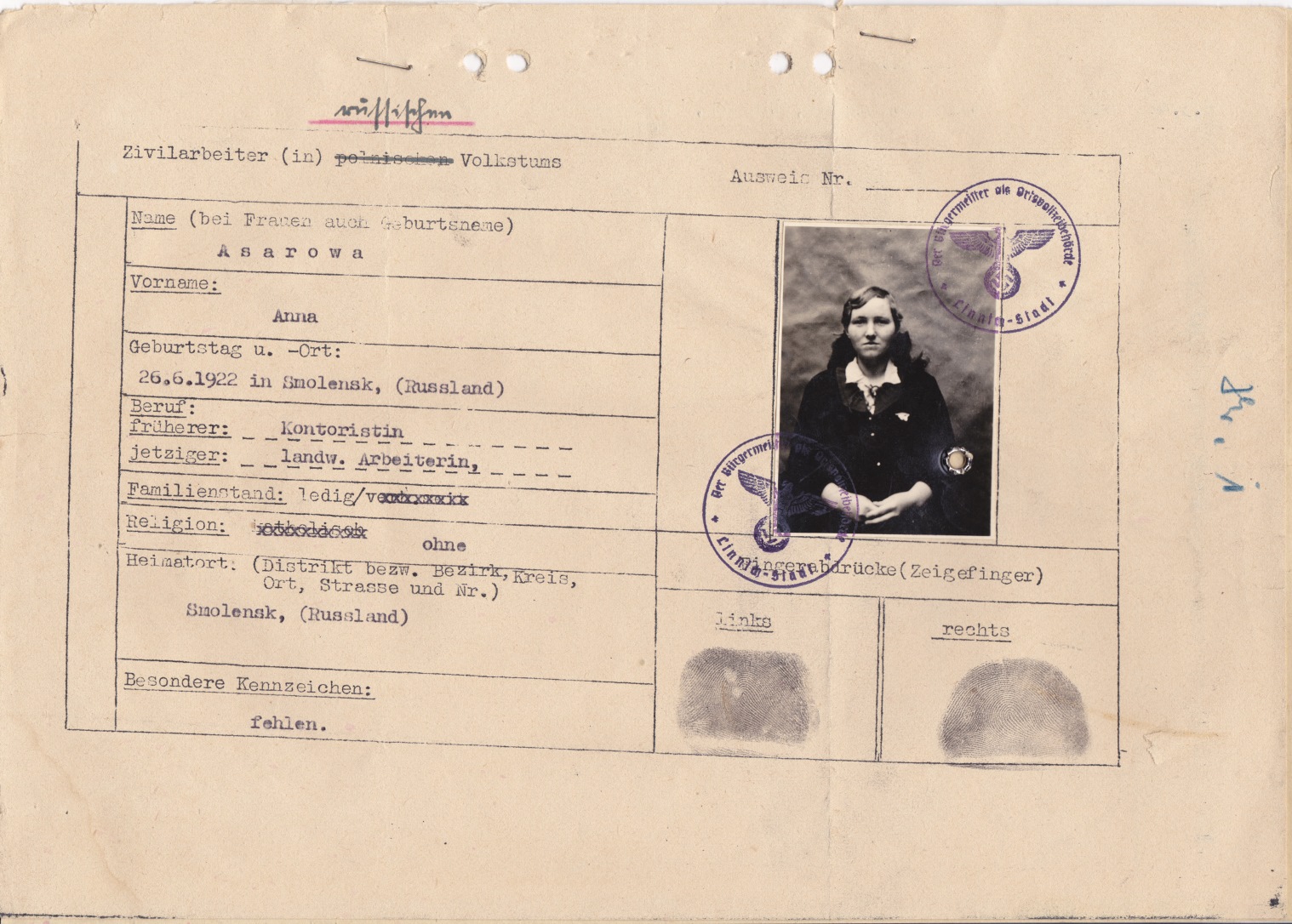
The Nazi Ostarbeiter (Eastern Worker) Program

Smolensk was a strategic center, only 320 km (200 mi) from Moscow, the city was the scene of two major battles during the German invasion in World War II, one in July 1941 and the other in 1943. Anna was conscripted in May 1942.
The document is a Personalkarte for a civilian worker of Russian nationality. "Polish" has been crossed out and "Ruessischen" substituted by hand. Her name was Anna Asarowa. She was born 26 June 1922 in Smolensk. Of interest is her prior (Frueherer) occupation (Beruf) as an office worker (Kontoristin) and current (jetziger) occupation as an agricultural laborer. She had no particular distinguishing marks (Besondere Kennzeichen: "Fehlen" means lacking or missing). Her photo is attached to this document with a single metal rivet and tied by two round eagle stamps for the Mayor (Burgermeister) in his capacity as the local police authority (als Ortspolizeibehoerde) for the city of Linnich (Linnich-Stadt). Her fingerprints are on the document as well. She was employed as an agricultural laborer and her length of stay was unknown.
This document is one of many boxed up by an American officer in 1945, then mailed to his wife. They were part of the official files in the Dienststelle which handled forced labor from the east in this particular area.
Background
The Ostarbeiter program brought conscripted labor from the occupied east to the Reich. These young people were essentially prisoners, slave laborers -- restricted to their place of residence (in some cases labor camps) and forbidden to fraternize with Germans.
Most Ostarbeiters were Polish or Russian. Such workers were required to wear an identification patch with "Ost." Because they were regarded as subhuman, they were ordered to be separated from the Germans. Those who tried to escape were hanged where other workers could see their bodies.
Many Ostarbeiters perished in Germany because the German authorities ordered that "they should be worked to death." Others who were working in German factories were killed in Allied bombing raids.
Returning Home
Those who returned home were physically and spiritually broken; moreover, they were considered by the authorities as having "questionable loyalty," and were therefore discriminated against and deprived of many of their citizenship rights.
Every person applying for a job had to fill the infamous "anketa" (questionnaire) and people with the "wrong" nationality or "past" were severely limited in their rights to travel, work, etc. Soviets captured many German archives and could verify this information about many people.
In extreme cases, some workers, when returned to the Soviet Union after the war, were incarcerated in Gulags or executed as collaborators.
The Ukrainian Ostarbeiters
During the German occupation of Ukraine in World War II (1941-1944), about 2.3 million Ukrainians were taken to Germany to work as slave laborers.
The story of the Ostarbeiters who were mostly from the territory of Reichskomissariat Ukraine (eastern Ukraine) is not known. Information about these people, how they were chosen, how they lived and worked, and how they perished or survived is largely unknown. Germany has since paid some compensation to some survivors.
According to the granddaughter of an Ostarbeiter named Maria Rupa, "My grandmother was an Ostarbeiter from the Ukraine - she was taken to Germany at the age of 14. The Germans came to their town and took the oldest child of every family. She had an older sister who was very frail and very attached to their mother, so my grandmother went instead. She did say this was common - the taking of the oldest child of every family."
Eyewitness accounts of the Ukrainian Ostarbeiter experience are virtually non-existent although there were 2,244,000 of them from Ukraine, according to historian Yuri Kondufor. A total of 3 million Ostarbeiters were taken to Germany, so Ukrainians constituted about 75 percent of the entire total. Ukraine, according to some sources, lost about 10 million people in World War II, which was the greatest loss of any country in the war.
More Documents
An Ostarbeiter's Employment Identification Document